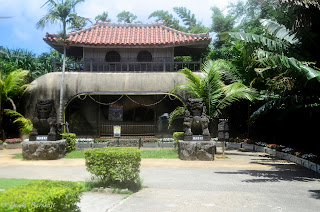 |
| Kijimuna directing us to the village |
 |
| One of two water buffaloes in the village |
 |
| The Sugar Cane Mill |
For a small fee you can participate in learning various Okinawan crafts like pottery, painting shisa dogs, jewelry making, fabric dying, corral lamps and even how to play a Sushin (three stringed instrument). You can have photos taken in kimonos and experience a tea ceremony. Throughout the day they have various programs at each of the houses and the theater. We went to watch the Eisa Taiko Drummers show and then watched a show about Habu snakes. I say watched because we couldn't understand what the man was saying. We gathered that the first snake he showed us looks like a habu and tries to strike at you when threatened but isn't poisonous. He was swinging that one over the audience which made me glad I was on the sidelines. The second snake was a true habu and after talking about it, he then grabbed it by its head. At the end of his show he allowed anyone who wanted to take pictures wear it around their necks. We watched all the young kids doing this and decided to be brave and try it ourselves. I can now say I've met a habu snake up close and personal. Ahhhh!! You can read more about habu snakes here and here.
The employees walked around in traditional Okinawa attire and were quite happy to stop for a picture with a peace sign. Even the trash lady was dressed in a cute outfit and hat. As you exit the village there are many restaurants serving various noodle and curry dishes as well as souvenir shops. I bought a bar of habu soap because it said it was good for healing the skin from signs of aging. (I was mostly intrigued as to whether it would help the skin problems I've had since wintertime--see next blog post) I thoroughly enjoyed visiting the village and think I'd like to go back and see more of the shows and maybe even try a few of the crafts. It's not too far from my home so I'm sure I'll visit it again before we leave the island.
 |
| This little emotionless Sanshin player made me smile because other than when he was singing he held this pose the entire time. |
 |
| Cute little trash lady. |
 |
| Inside one of the homes |
 |
| I want a tree house like this one. |
 |
| Cooking stove with a modern fan thrown in |
 |
| Sweet lady directing us to the Eisa show |
 |
| This girl could whistle as good as the men. Rarer to see a female Taiko drummer I think |
 |
| After their show they posed for pictures |
 |
| Had to have a picture reminding me of when I was there. |
 |
| Old style transportation and a thatched roof house |
 |
| One of the restaurants in the village |
 |
| Costumes of some of the workers |
 |
| Water mill and stone wall |
 |
| Two people trying to learn to play the Sanshin |
 |
| Entrance to the Village |
 |
| Traditional Okinawan costume |
 |
| Another worker happy to pose for a picture |
 |
| Entrance to the Habu and Eisa Shows |
 |
| Pottery Class |










No comments:
Post a Comment